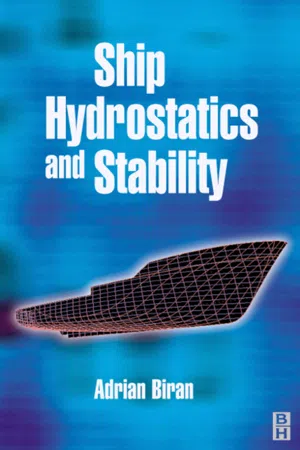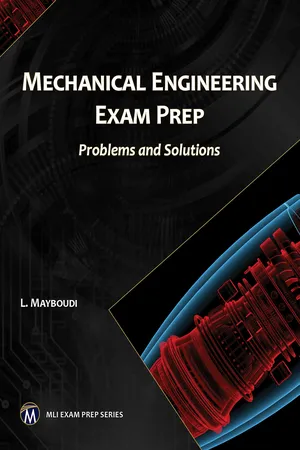Physics
Archimedes' Principle
Archimedes' Principle states that an object immersed in a fluid experiences an upward buoyant force equal to the weight of the fluid it displaces. This principle explains why objects float or sink in fluids and is fundamental to understanding buoyancy. It is used to calculate the buoyant force acting on objects in various applications, such as shipbuilding and designing flotation devices.
Written by Perlego with AI-assistance
Related key terms
1 of 5
9 Key excerpts on "Archimedes' Principle"
- Ahlam I. Shalaby(Author)
- 2018(Publication Date)
- CRC Press(Publisher)
2.5.1Buoyancy and Archimedes PrincipleThe linear increase of the hydrostatic pressure, p in a fluid with depth, z (hydrostatic pressure equation, (dp /dz ) = γ ) results in the existence of an upward vertical force called the buoyant force,2.5.1.1Magnitude and Location of the Buoyant ForceFB. One may observe the existence of the buoyant force,FBwhen a body of any given density, ρ is submerged in the fluid. The buoyant force,FBtends to lift the body upward. Thus, buoyancy or the buoyant force,FBis defined as the hydrostatic force exerted by the fluid on the surface of a submerged body that is either floating or suspended (naturally or manually) in the fluid (as opposed to a submerged body that is anchored, as in Section 2.4 ). The weight,FG= Mg = W = γV of a submerged floating or suspended body (object) appears to decrease due to the buoyant force,FB. While the magnitude of the buoyant force,FBcan be significant when the fluid is a liquid, it is negligible in most applications when the fluid is a gas. The Archimedes principle provides the basis for the determination of the buoyant force,FBand is stated as follows: the weight, W of a submerged body is reduced by an amount equal to the buoyant force,FB, which has a magnitude equal to the weight of the fluid displaced by the body and acts vertically upward through the centroid of the displaced volume.Depending upon the density of the body relative to the density of the fluid, one of three cases (occurrences) will take place; thus, the relationship between the buoyant force,FBand the weight of the body, W is defined. The three cases include: (1) an immersed/completely submerged sinking body, (2) an immersed/completely submerged neutrally buoyant/suspended body, and (3) a partially submerged/floating body. The magnitude of the buoyant force,FBis independent of the distance of the body from the free surface; the geometry of the body; and the density of the sinking, neutrally buoyant/suspended, or floating body. Regardless of whether the body is designed to remain floating or to remain neutrally buoyant/suspended in the fluid (or sink to the bottom), the weight, W of the body acts downward through the center of gravity, G of the body and is designed to be equal in magnitude to the weight of the fluid displaced by the body, the buoyant force,FB, which acts through the “center of buoyancy,” B . However, in the case of the buoyancy of a completely submerged sinking body (see Section 2.5.1.2 ), the weight, W of the body actually exceeds the buoyant force,FB- eBook - PDF
- Adrian Biran(Author)
- 2003(Publication Date)
- Butterworth-Heinemann(Publisher)
The results hold the same for single-hull ships as for catamarans and trimarans. The only problem is that the treatment of the problems for general-form floating bodies requires ‘more’ mathematics than the calculations for certain simple or symmetric solids. To make this chapter accessible to a larger audience, although we derive the results for body shapes without any form restrictions, we also exemplify them on parallelepipedic and other simply defined floating body forms. Reading only those examples is suf-ficient to understand the ideas involved and the results obtained in this chapter. However, only the general derivations can provide the feeling of generality and a good insight into the problems discussed here. 2.2 Archimedes’ principle 2.2.1 A body with simple geometrical form A body immersed in a fluid is subjected to an upwards force equal to the weight of the fluid displaced. The above statement is known as Archimedes’ principle . One legend has it that Archimedes (Greek, lived in Syracuse – Sicily – between 287 and 212 bc ) discovered this law while taking a bath and that he was so happy that he ran naked in the streets shouting ‘I have found’ (in Greek Heureka , see entry ‘eureka’ in Merriam-Webster, 1991). The legend may be nice, but it is most probably not true. What is certain is that Archimedes used his principle to assess the amount of gold in gold–silver alloys. Archimedes’ principle can be derived mathematically if we know another law of general hydrostatics. Most textbooks contain only a brief, unconvincing proof based on intuitive considerations of equilibrium. A more elaborate proof is given here and we prefer it because only thus it is possible to decide whether Archimedes’principle applies or not in a given case. Let us consider a fluid whose specific gravity is γ . Then, at a depth z the pressure in the fluid equals γz . This is the weight of the fluid column of height z and unit area cross section. The - eBook - PDF
Advanced Transport Phenomena
Analysis, Modeling, and Computations
- P. A. Ramachandran(Author)
- 2014(Publication Date)
- Cambridge University Press(Publisher)
4.2.1 Archimedes’ principle Consider a solid body immersed in a liquid as shown in Fig. 4.8 . The pressure force acts on the surface of the body and is given by Pressure force = A ( − p ) n dA = V −∇ p dV We now use the equation of hydrostatics as ∇ p = ρ l g , where ρ l is the liquid density. Hence Pressure force = V − ρ l g dV = − ρ l g V We have Total force = Pressure force + Weight of the solid 170 Forces and their representations Pressure LIQUID Solid Gravity Figure 4.8 A diagram showing the forces on a solid immersed in a liquid, demonstrating Archimedes’ principle. The net pressure force is upwards and reduces the weight of the immersed body. Centroid Pressure = ρ g η cos α η d = η cos α α Solid surface for analysis L 1 L 2 LIQUID Center of pressure Figure 4.9 A diagram for force calculation on a plane surface. The surface between η = L 1 and η = L 2 is being analyzed. Therefore Total force = (ρ s − ρ l ) g V which is less than the weight of the body in the absence of the liquid, ρ s being its density. The weight of the body (total force) measured in the liquid is decreased by ρ l g V , which is equal to the weight of the liquid displaced by the body. This is the famous Archimedes principle, which is proved here using the equation of hydrostatics and vector calculus. Archimedes deduced it by intuition, but the formal proof had to wait for 1600 years until the invention of the vector calculus. 4.2.2 The force on a submerged surface: no curvature In many applications of hydrostatics it is required to find the force on a submerged surface in contact with water. The calculation on a plane surface (surface with no curvature) is shown here as an illustrative example. See Fig. 4.9. 171 4.2 The equation of hydrostatics Let η be the coordinate measured from the surface of the liquid in the direction of the plate. Let us consider the force on the plate between η = L 1 and η = L 2 . The pressure at any point is ρ gd , where d is the height measured from the top. - eBook - ePub
Making Physics Fun
Key Concepts, Classroom Activities, and Everyday Examples, Grades K?8
- Robert Prigo(Author)
- 2015(Publication Date)
- Skyhorse(Publisher)
But this is the same buoyant force that is being exerted on the steel and foam balls. Eureka! We can only conclude that the buoyant force on the steel and foam balls must equal the weight of this liquid ball. Since this liquid ball has the same shape as the other balls, the weight of the liquid ball is identical to the weight of the liquid displaced by the other balls. We have found the answer to our question. Known as Archimedes’ Principle, the buoyant force on an object is always equal to the weight of the fluid displaced by the object. It works for both gases (like the atmosphere) and liquids (like water) near the surface of a planet (like Earth). Indeed, an object in the atmosphere feels a buoyant force equal to the weight of the air displaced by the object. An object in a liquid feels a buoyant force equal to the weight of the liquid displaced by the object. A totally submerged object will sink if its weight is larger than the weight of the fluid it displaces. A totally submerged object will rise if its weight is less than the weight of the fluid it displaces. A totally submerged object will flink if its weight is exactly equal to the weight of the fluid it displaces. The above three cases can also be interpreted in terms of density (weight or mass per volume). Since a totally submerged object displaces an amount of fluid equal to its volume, we can conclude that objects denser than the fluid will sink, less dense than the fluid will rise, and of equal density will flink. An object floating at the surface of a liquid is not totally but only partially submerged in the liquid. Since the buoyant force still equals the weight of displaced fluid, the floating object needs to displace only a volume of liquid whose weight is exactly equal to its own weight. Activities Aluminum Ball and Pancake: You will need to locate some aluminum foil, a hammer, and a container of water. Cut two identical sheets of aluminum foil (same size) - eBook - PDF
- John D. Cutnell, Kenneth W. Johnson, David Young, Shane Stadler, Heath Jones, Matthew Collins, John Daicopoulos, Boris Blankleider(Authors)
- 2020(Publication Date)
- Wiley(Publisher)
FIGURE 11.16 The fluid applies a downward force P 1 A to the top face of the submerged cylinder and an upward force P 2 A to the bottom face. h A P 1 A P 2 A We have substituted P 2 − P 1 = gh from equation 11.4 into this result. In so doing, we find that the buoyant force equals ghA. The quantity hA is the volume of liquid that the cylinder moves aside or displaces in being submerged, and denotes the density of the liquid, not the density of the material from which the cylinder is made. Therefore, hA gives the mass m of the displaced fluid, so that the buoyant force equals mg, the weight of the displaced fluid. The phrase ‘weight of the displaced fluid’ refers to the weight of the fluid that would spill out if the container were filled to the brim before the cylinder is inserted into the liquid. The buoyant force is not a new type of force. It is just the name given to the net upward force exerted by the fluid on the object. The shape of the object in figure 11.16 is not impor- tant. No matter what its shape, the buoyant force pushes it upwards in accord with Archimedes’ principle. It was an impressive accomplishment that the Greek scientist Archimedes (ca. 287–212 BC) discovered the essence of this principle so long ago. Archimedes’ principle Any fluid applies a buoyant force to an object that is partially or completely immersed in it; the magnitude of the buoyant force equals the weight of the fluid that the object displaces: F B ⏟ ⏟ ⏟ Magnitude of buoyant force = W fluid ⏟ ⏟⏟ Weight of displaced fluid (11.6) The effect that the buoyant force has depends on its strength compared with the strengths of the other forces that are acting. For example, if the buoyant force is strong enough to balance the force of gravity, an object will float in a fluid. Figure 11.17 explores this possibility. In part a, a block that weighs 100 N displaces some liquid, and the liquid applies a buoyant force F B to the block, according to Archimedes’ principle. - eBook - PDF
Physics of Continuous Matter
Exotic and Everyday Phenomena in the Macroscopic World
- B. Lautrup(Author)
- 2011(Publication Date)
- CRC Press(Publisher)
3 Buoyancy and stability “Buoy”, pronounced “booe”, probably of Germanic origin. A tethered floating object used to mark a location in the sea. Fishes, whales, submarines, balloons, and airships all owe their ability to float to buoyancy , the lifting power of water and air. The understanding of the physics of buoyancy goes back as far as antiquity and probably sprung from the interest in ships and shipbuilding in classic Greece. The basic principle is due to Archimedes. His famous law states that the buoyancy force on a body is equal and oppositely directed to the weight of the fluid that the body displaces. Before his time it was thought that the shape of a body determined whether it would sink or float. Archimedes of Syracuse (287– 212 BC). Greek mathematician, physicist, and engineer. Dis-covered the formulae for area and volume of cylinders and spheres, and invented rudimen-tary infinitesimal calculus. For-mulated the Law of the Lever, and wrote two volumes on hy-drostatics titled On Floating Bod-ies , containing his Law of Buoy-ancy. Killed by a Roman soldier. (Source: Photograph of Fields Medal courtesy Stefan Zachow. Wikimedia Commons.) The shape of a floating body and its mass distribution do, however, determine whether it will float stably or capsize. Stability of floating bodies is of vital importance to shipbuilding, and to anyone who has ever tried to stand up in a small rowboat. Newtonian mechanics not only allows us to derive Archimedes’ principle for the equilibrium of floating bodies, but also to characterize the deviations from equilibrium and calculate the restoring forces. Even if a body floating in or on water is in hydrostatic equilibrium, it will not be in complete mechanical balance in every orientation, because the center of mass of the body and the center of mass of the displaced water, also called the center of buoyancy, do not in general coincide. - No longer available |Learn more
Mechanical Engineering Exam Prep
Problems and Solutions
- Layla S. Mayboudi, S. Musa, PhD(Authors)
- 2021(Publication Date)
- Mercury Learning and Information(Publisher)
(a) tendency of an object to accelerate (b) floating principle (c) Archimedes principle (d) equilibrium principleThe buoyant force can be expressed by the formula (ρfluid is fluid density, Vfluid and Vdisplac are fluid volume and displaced volume, and g is acceleration gravity):(a) ρfluid Vdisplac g(b) ρfluid Vfluid g(c) rdisplaced Vdisplaced g(d) ρdisplaced Vfluid gA 4 × 5 × 2-m3 brick-shaped lead block is kept submerged in a mercury bath of sufficient size to contain the block. If the specific gravity of lead is 11.34 while the specific gravity of mercury is 13.59, the force required to keep it below the liquid surface is:(a) 883 kN (b) 4,449.8 kN (c) 88.3 kN (d) 5,332 kNA solid object of volume V is submerged in water. If the net downward force is 20,000 N, the specific gravity of the object (SG) is:- A solid object is sinking in a lake. As the object sinks deeper, the buoyant force: (a) increases (b) decreases (c) remains the same (d) approaches zero
A solid object of 1 m3 volume is kept submerged by force in a pool of water. If the force required to keep it submerged is 5,000 N, the specific gravity of the object (SG) is:(a) 1 (b) 2 (c) 0.5 (d) 1.5A solid object of 1 m3 volume is floating in a pool of water. 50% of the object’s volume is below the water surface. The density of the object (ρ) is:(a) 1,010 kg/m3(b) 500 kg/m3(c) 550 kg/m3(d) 2,020 kg/m3A solid object (ρ = 2,000 kg/m3 ) is floating in a pool of mercury (ρ = 11,340 kg/m3 ) while displacing 0.1 m3 of the fluid. The buoyant force it experiences is:(a) 11.1 kN (b) 2.0 kN (c) 9.2 kN (d) 13.1 kNOne-meter high and 2-m diameter cylindrical balloons are filled with helium (ρ = 0.178 kg/m3 ) and are used to lift a solid spherical mass with the 1-m diameter and 150 kg/m3 density. The mass is located on the Earth’s surface with the air density of 1.225 kg/m3 - eBook - ePub
- Paul Sandori(Author)
- 2016(Publication Date)
- Dover Publications(Publisher)
CHAPTER FIVEWater and AirMore paradoxes and a horror that is notThe Force of Buoyancy — The Pressure of Water — The Hydrostatic Paradox — The Hydraulic Machine — The Horror of the Vacuum — The Atmospheric Engine — ExampleTHE FORCE OF BUOYANCYHow can a heavy ship (Fig. 5.1 ) complete with equipment and cargo stay afloat? The discovery of the principle of buoyancy is credited to Archimedes who, according to legend, was so excited when he found the answer while immersed in water that he streaked naked from his bath shouting “Eureka! I have found it!”Two thousand years later, Stevin explained the principle of buoyancy in the following way. Imagine a mass of water D inside a larger mass of the same fluid (Fig. 5.2 ). Further imagine the surface of the water D solidified so that it surrounds the water inside on all sides. This imaginary container is without mass and infinitely thin. Mass D must be supported by the rest of the water so that it is in equilibrium, or else it would fall or rise. If that was the case it would be continuously replaced by other water filling the gap and we would have perpetual motion, which is just as absurd here as in the problem of the inclined plane. Therefore mass D is at rest inside the total mass of water. Gravity pulls it down with a certain force (the weight of the water D); the surrounding water holds it up with an equal force.Next pour the water out of the container, so that volume D remains empty. The surrounding water is unaware that anything has happened and it continues to push the container up with the same force as before. If we place inside the container a solid body A - David Halliday, Robert Resnick, Jearl Walker(Authors)
- 2023(Publication Date)
- Wiley(Publisher)
14.1.1 as ρ = m _ V . (14.1.2) Fluid Pressure A fluid is a substance that can flow; it conforms to the boundaries of its container because it cannot withstand shearing stress. It can, however, exert a force perpendicular to its surface. That force is described in terms of pressure p: p = ΔF _ ΔA , (14.1.3) in which ∆F is the force acting on a surface element of area ∆A. If the force is uniform over a flat area, Eq. 14.1.3 can be written as p = F _ A . (14.1.4) The force resulting from fluid pressure at a particular point in a fluid has the same magnitude in all directions. Gauge pressure is the difference between the actual pressure (or absolute pressure) at a point and the atmospheric pressure. REVIEW & SUMMARY Pressure Variation with Height and Depth Pressure in a fluid at rest varies with vertical position y. For y measured positive upward, p 2 = p 1 + g( y 1 − y 2 ). (14.2.3) The pressure in a fluid is the same for all points at the same level. If h is the depth of a fluid sample below some reference level at which the pressure is p 0 , then the pressure in the sample is p = p 0 + gh. (14.2.4) Pascal’s Principle A change in the pressure applied to an enclosed fluid is transmitted undiminished to every portion of the fluid and to the walls of the containing vessel. Archimedes’ Principle When a body is fully or partially sub- merged in a fluid, a buoyant force → F b from the surrounding fluid acts on the body. The force is directed upward and has a magnitude given by F b = m f g, (14.5.1) where m f is the mass of the fluid that has been displaced by the body (that is, the fluid that has been pushed out of the way by the body). When a body floats in a fluid, the magnitude F b of the (upward) buoyant force on the body is equal to the magnitude F g Questions 403 of the (downward) gravitational force on the body. The apparent weight of a body on which a buoyant force acts is related to its actual weight by weight app = weight − F b .
Index pages curate the most relevant extracts from our library of academic textbooks. They’ve been created using an in-house natural language model (NLM), each adding context and meaning to key research topics.








